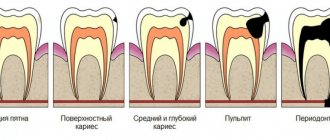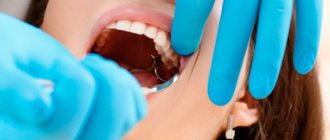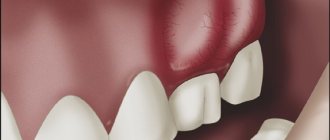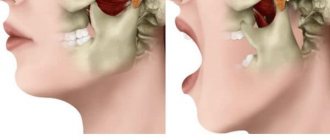Why use
Everyone has long known that arsenic is a poison and has a toxic effect. In large dosages, it poses a mortal danger to humans. But, despite this fact, the substance is actively used in dental practice. He has not only disadvantages, but also advantages. The drug quickly destroys the exposed nerve and provides a powerful analgesic effect. Most often it is used for inflammatory processes of various localizations, which are accompanied by severe pain. It is not used in its pure form, but with various additives: antiseptics, lidocaine, novocaine, tannide.
Now there are many other, safer means for health, used when removing a nerve. Arsenic is not used often, only when there are certain indications. Also, there are several contraindications:
- individual intolerance;
- period of pregnancy and breastfeeding;
- younger children;
- limited access to dental canals;
- diseases of the genitourinary system.
Features of using the drug
The dose of arsenic used in dentistry does not cause serious harm to the body, but it does affect the structure of the dental system. The product is placed on the tooth to kill the nerve to protect against subsequent pain. A small amount of the drug used for the right time is safe for the patient.
However, before this procedure, the specialist is obliged to check the patient for contraindications to the use of this therapy. Despite their small number, the dentist must take into account all the features of using arsenic individually for each patient.
There are the following contraindications for using the drug:
- The existence of serious problems with the genitourinary system.
- Intolerance to any elements of arsenic paste.
- Children of age , pregnancy and breastfeeding.
- The restricted path to the canals and the absence of the possibility of local use of arsenic.
Many treatment processes in dentistry are performed with arsenic paste. Most often, it eliminates severe pain when removing deep caries that has reached the pulp. Before treatment, the specialist must inform the patient about the purpose of arsenic and the amount of time the product remains on the tooth.
To fix the paste, a temporary filling is placed on the treated area. When the prescribed period expires, the doctor removes the arsenic and continues treatment. Two days are enough to kill the nerve.
The maximum duration of use of the drug is one week. If the product is not removed on time, it begins to have a detrimental effect on the state of the microflora inside the tooth and its activity. If the paste falls out on its own, you should not hesitate to visit a doctor.
How long can you keep arsenic?
When treating multi-channel teeth, dentists apply the substance for a period of one to three days. In some cases, the composition is left to act for a week. For children, the drug is given for a shorter time, no more than 18 hours. Pregnant women should not be given arsenic at all. This is done in very rare cases. Experts believe that it can negatively affect the development of the fetus.
Read more in the article: How long can you walk with arsenic in your tooth?
When installing a paste with a substance, you must carefully ensure that the seal is airtight. Contact of arsenic with healthy tissues is not allowed.
What is nerve removal?
As you know, a tooth is not just bone tissue. Each tooth has nerve endings located in the pulp chamber. It is when exposed to a bundle of nerve endings and blood vessels that a person experiences discomfort and pain. Removing the nerve leads to the fact that the supply of nutrients to the tooth tissues stops, and the tooth gradually dies.
When we hear about nerve removal, we are talking specifically about the pulp chamber. It is this area of the tooth that is responsible for the reaction to any mechanical and temperature stimuli. After removal, the tooth will no longer react to cold and hot, the patient will no longer complain of discomfort when food particles get on the tooth.
Over time, a tooth without pulp may change color, become dull, and more fragile than before. However, despite all these consequences, sometimes removing the nerve is a necessary procedure. It allows you to reduce pain and do without implantation - removing a tooth and replacing it with an artificial pin with a crown.
How to clean
This manipulation should be approached with all responsibility. All rules must be followed so as not to cause harm. It is very important to pay attention to disinfection. The workplace should be well lit. If there are someone close to you, then it is better to enlist their help. If there is no one, then you can simply arm yourself with a mirror.
Procedure algorithm:
- Brush your teeth, remove plaque.
- Wash your hands using an antibacterial product.
- Select the tool that you plan to use to extract arsenic. It could be a syringe, a sewing needle or any other. Wipe it with a solution of potassium permanganate or alcohol.
- Using smooth and careful movements, remove the upper part of the soft filling material. We must try to act in such a way as not to violate the integrity of the substance. Don't go too deep to avoid damaging your gums. The extracted gray pulp is immediately pulled out of the mouth. If you accidentally swallow it, it can cause serious consequences.
After the manipulation is completed, it is recommended to rinse your mouth with a soda solution or chamomile decoction. Apply sterile gauze to the tooth, which will act as a barrier between the dead nerve and the food. It is advisable to visit a doctor on the same day so that he can install a filling.
Self-removal of arsenic paste from a tooth
If it is not possible to visit the dentist and get the medicine in a hospital setting, then you should take the medicine out with your own hands, which should be washed. Before starting the procedure, the oral cavity must be thoroughly cleaned. To remove it, you will need a toothpick with the tip treated with alcohol.
When the temporary filling is successfully removed, a grayish arsenic paste is also removed. This must be treated carefully, as it should not crumble. After completely cleaning the tooth, rinse your mouth with chamomile solution. Subsequent treatment must be done by a doctor, otherwise the damaged tooth will be destroyed.
If you overexpose arsenic
If the substance is not removed from the tooth within the recommended period, the adjacent tissues will suffer. In advanced cases, intoxication of the body may develop.
Cases have been recorded when a small amount of the drug remained forever in the dental cavity.
Other common complications:
- gum burn;
- darkening of the enamel;
- pulp swelling;
- pathological processes in neighboring teeth;
- damage to the periosteum and bone;
- periodontitis.
You should only remove arsenic from a tooth yourself as a last resort. To reduce risks, experts advise taking care of the filling, eating only on the healthy side, and not planning trips during treatment. If you take medical recommendations as responsibly as possible, you can prevent unpleasant consequences.
Arsenic in the tooth: what to do if it still hurts?
Arsenic in dentistry is used to reliably kill the diseased nerve of the tooth. This technique has long been known and is slowly giving way to modern methods of anesthesiology. However, modern specialists still often practice the use of arsenic.
Arsenic in the tooth: the tooth hurts, you need to block the pain
In diseases such as caries, pulpitis or periodontitis, the inflamed dental nerve causes severe pain. In order to “kill” the diseased nerve, a special arsenic paste is used, the dosage of which is calculated individually for each patient. After putting the paste into the affected tooth, the doctor sets the time for the next appointment, which cannot be postponed. You can walk around with arsenic in your tooth for no more than three days!
What to do if there is arsenic in the tooth, but the tooth still hurts?
As a rule, arsenic quite quickly carries out the process of necrotization of the pulp, and the tooth stops hurting. But it also happens that there is arsenic in the tooth, but it still hurts. Most often, the pain after placing a temporary filling with arsenic subsides gradually over one to two days. If, after this period, the tooth continues to hurt, this can be caused by various reasons:
- pain is your body's reaction to the drug;
- temporary filling has an irritating effect;
- the doctor has chosen the wrong dosage of the drug for you;
- the medicine was installed incorrectly;
- osteonecrosis has occurred;
- the inflammation process has gone beyond the pulp.
In any of the indicated cases, you should immediately consult a doctor, because tooth pain that does not stop after arsenic is present is a very alarming sign.
What to do as first aid before you visit the dentist?
In order to relieve pain, we advise you to take some anti-inflammatory non-steroidal drug. For example, diclofenac, nurofen, ibuprofen, etc. Ordinary analgin can also help. Do not self-medicate under any circumstances - do not rinse the sore tooth with warm solutions and do not apply heat to the sore spot. If the pain is unbearable, and there is still a long time before visiting a doctor, you can try to remove the medicine yourself, but under no circumstances swallow or chew it, and after removing it, rinse your mouth thoroughly.
You can get a consultation at the DENTISTRY clinic. Make an appointment by calling +7 (8342) 308–088 or using the form below.
Make an appointment
Indications for nerve removal
According to statistics, the main reason for removing the nerve of a tooth is advanced pulpitis, that is, carious tissue damage. If this pathology is ignored and left untreated for a long time, the enamel and deeper layers of dentin are destroyed, and the nerve may be exposed. As a result, the patient may complain of unbearable pain at the slightest contact with the tooth.
As a rule, removal of a nerve is a consequence of a neglectful attitude towards one’s health and the health of one’s teeth. Carious holes that are left untreated for a long period of time lead to pulp damage. That is why experts strongly recommend regularly visiting the clinic for preventive examinations.
In this case, the removal of the nerve can be either complete or partial. This depends on the degree of damage to the tooth and the possibility of further treatment, but the final decision is always made by the attending dentist after examination. Usually, partial removal can be limited to cases where the inflammatory process has affected only the top of the pulp chamber. In this case, only dead tissue will be extracted.
If there is no other choice
After placing arsenic in the tooth cavity, the doctor sets a date for the next visit - the day on which it will be removed.
Moreover, it is not recommended to postpone the appointed date to a later date, even if the tooth has stopped hurting. This will lead to unnecessary complications, so leaving arsenic anhydride in the tooth for more than 3 days is unacceptable. If for some reason it is not possible to visit the dentist, and the appointed time is already approaching, then you can try to remove the arsenic yourself or ask your loved ones to do it.
Disinfection is a mandatory step
This procedure must be approached responsibly and in compliance with the rules of disinfection. First you need to brush your teeth, thoroughly wash your hands with an antibacterial agent, wipe the sewing needle, syringe or other suitable tool with alcohol or a solution of potassium permanganate.
Stand in front of a mirror and provide the area for the procedure with good lighting. Remove the top part of the soft temporary filling, do not go below it and try not to touch the gum. The movements should be smooth, but at the same time fast enough to pull out the grayish mush.
Under no circumstances should you swallow the extracted paste; this will lead to serious consequences.
After successfully removing the medication, you should rinse your mouth with a chamomile decoction or a soda solution. Apply a cotton swab, which will serve as a barrier between the food and the killed nerve. See your dentist soon as the damaged nerve will decompose along with an inflammatory reaction, causing further problems.
Methodology
Modern treatment methods make it possible to completely remove the tooth nerve in just one clinic visit and absolutely without pain. The anesthetic begins to act a few minutes after the administration of the required dose; there are no negative consequences after its use.
At the first stage of nerve removal, the tooth is opened and access to the pulp is provided. The affected areas are removed using special devices; the entire procedure takes no more than 30-40 minutes. After this, the dentist begins filling the canals and installing a permanent filling. Often, a temporary filling is first installed; this is required in order to evaluate the effectiveness of the pulp removal performed and simply to be on the safe side.
Partial removal of the nerve and preservation of the root part of the pulp chamber allows you to prolong the life of the diseased tooth, so this treatment method is especially relevant for children and adolescents. In any case, the dentist will do everything possible to preserve the dentition without the need for prosthetics or installation of implants.
previous post
How to make your teeth straight
next entry










